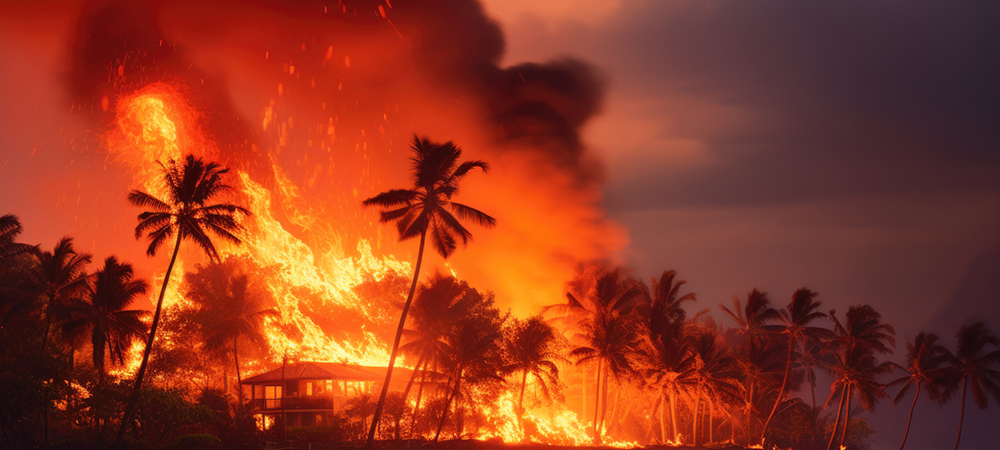Todd Rigby, Director of Sales, Rajant Corporation, tells of what BreadCrumbs brought to the table in restoring key comms operations after the Maui wildfires of August 2023.
The Hawaiian island of Maui fell victim to one of the deadliest infernos on record in August 2023.
This was brought on by Hurricane Dora, which passed 500 miles to the South – the wind blew down power lines and ignited overgrown brush.
The resulting fires swept across the island at a significant pace, resulting in many casualties and destroying the region’s homes, buildings and critical communications infrastructure.
With 19 out of 21 wireless cell sites that serve Kapalua, Napili-Honokowai, Kaanapali, Lahaina, Launiupoko, and Olowalu out of service, communication providers were desperate to fix their damaged network equipment.
Maui needed a resilient network to restore communications swiftly, all while navigating the harsh conditions of the blaze.
For first responders and those in charge of extinguishing the fires, having access to networking services that enable real-time updates and information is vital.
Maui relied heavily on wired Internet and telephone, along with cellular service for their voice and data communications – there was no public Wi-Fi to speak of.
The lack of communications complicated rescue and recovery efforts. The wildfires subsequently brought down utility poles and cut off power, which made restoring communications a larger problem.
In remote areas that relied on wireless connectivity, cell towers surrendered to the heat and shut down.
With cell sites, one key issue is that a cell tower is a single point of failure – if the connection is interrupted the entire cell site goes offline.
Besides destroying cell sites, the wildfires also wreaked havoc on the fiber optic cables and other fixed services on the island used to backhaul the traffic to the cell sites.
When this happens, it can take days or even weeks to get the network operational again.
According to an FCC report, over 25,000 subscribers were without related services.
With the county reluctant to activate its audible warning sirens due to fears that people would think a tsunami was coming, citizens’ only hope of updates was through the Internet and social media.
Had residents taken usual precautions for tsunamis by heading to higher ground, where the fires started, they would have been in even more danger.
To restore vital communications, a private company based in Maui took it upon itself to set up a community Wi-Fi project.
Some service providers deployed Cell on Wheels (COW) mobile cell towers to provide temporary enhanced cellular coverage.
But COWs are powered by satellite connections and often do not have the required bandwidth to support more than a few data connections at a time – as was the case in Maui.
The fire itself was also an obstruction to these technologies – it took the carriers 10 days to two weeks to get the first COWs operational.
Obstructions and sporadic connectivity in conjunction with limited bandwidth can prevent access to vital information, applications and real-time data.
In turn, this prevents the effective execution of crucial, life-saving tasks.
Maui has unique topography. On the west side of the Island, where Lahaina is located, the utilities follow the coastline because it is the easiest route.
There were several communities in North of Lahaina which were not directly affected by the wildfires, but suffered greatly as they lost power, water and communications.
As part of the efforts to support displaced residents, and affected communities, Rajant Corporation teamed up with Hawaiian technology solution provider SITECH Solutions.
The partnership supported the Community Wi-Fi effort with higher performing networking nodes called BreadCrumbs that could provide longer range connectivity with the cellular COWs focused on cleanup areas.
The enhanced coverage restored critical connectivity to businesses, residents and displaced people in West Maui.
Todd Rigby, Director of Sales, Rajant, said the company’s mesh network offers enhanced connectivity and can support the real-time delivery of voice, video and data.
“This is particularly useful for enabling the capabilities of drones, robots and other Industrial Internet of Things (IIoT) devices being used by frontline staff to monitor the emergency situations, and facilitate communications,” said Rigby.
Rajant creates a wireless mesh using BreadCrumb nodes which can be deployed on any asset, anywhere, to extend or improve operational coverage.
BreadCrumbs can also be attached to IIoT devices, drones, robotics or personnel.
Each BreadCrumb can make many concurrent active connections to ensure voice, video and data can be transmitted directly from a location to the central control center.
BreadCrumbs can also act as high-performance Wi-Fi access points enabling connectivity, even if traditional LAN connections are not available.
With access to real-time and critical information of a raging wildfire, firefighters and frontline crews can provide a timely and effective response to an evolving and unpredictable situation.
“To navigate robust and harsh environments, wireless mesh nodes can create a self-healing network by relaying information and data to establish multiple redundant connections.
“This means that people and their data can keep moving even if or when a node is damaged or lost in the blaze and ultimately enable 24/7/365 anywhere connectivity,” said Rigby.
“Wireless mesh networking technology can be deployed swiftly, being self-optimizing and resilient in ensuring that communications are consistently available – critical in enabling emergency services to undertake predictive and preventative measures to counter the complications inherent in a wildfire.
“When a dangerous situation, like the Maui wildfires, unfolds, having access to reliable and unfailing wireless connectivity keeps residents and businesses connected to their loved ones when they need it most.”
Joey Walker, Technology Manager, SITECH Solutions, said: “Thanks to Rajant’s BreadCrumb nodes our engineers were able to enhance the vital communications for frontline responders and citizens in a matter of days.
“Collaboration is essential in such devastation and need – this was reflected in our work with Rajant to provide much-needed connectivity to a region reeling from massive communication failure.”
Click below to share this article

